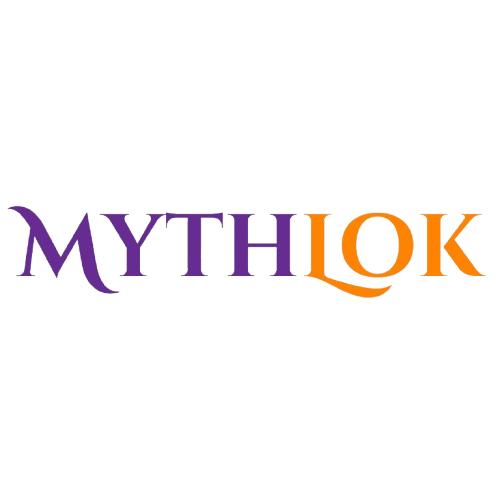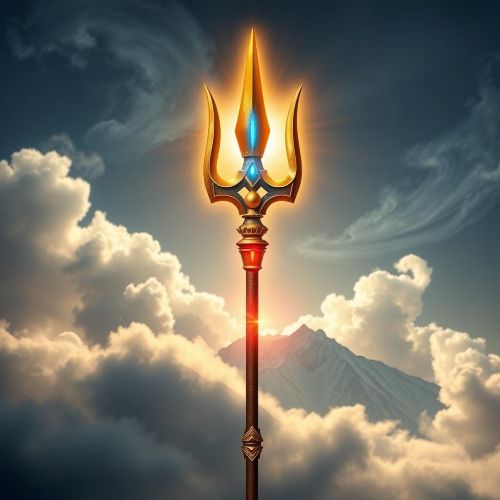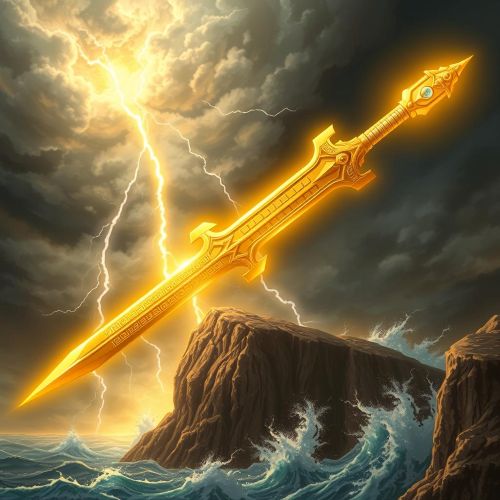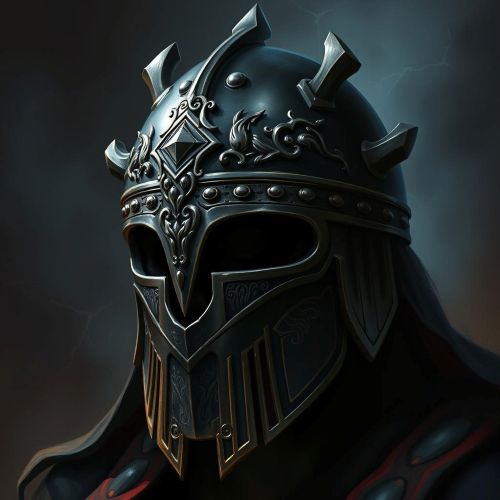Poseidon’s Trident : The Ruler of the Seas
Poseidon’s Trident
Introduction
In Greek mythology, Poseidon’s Trident stands out as one of the most iconic and potent weapons. More than a mere tool, this three-pronged spear symbolizes Poseidon’s authority over the sea, earthquakes, and horses, embodying the natural forces he controls. The trident’s significance goes beyond its physical form, deeply embedded in the myths and legends of the ancient Greeks. It reflects their reverence for the untamed power of the ocean and the awe inspired by Poseidon himself. Often depicted in ancient art, Poseidon’s trident is not just a weapon but a symbol of his unmatched dominion over the aquatic world.
Origins
The origins of Poseidon’s Trident are woven into the rich tapestry of Greek mythology. Crafted by the Cyclopes, renowned one-eyed giants with unmatched skill, the trident was created alongside Zeus’s thunderbolt and Hades’ Helm of Darkness during the great war known as the Titanomachy. These powerful weapons were designed to help the Olympians overthrow the Titans and establish their rule. For Poseidon, the trident became more than just a weapon—it was a symbol of his immense power and control over the sea, a realm filled with both beauty and danger.
After the Olympians’ victory, the universe was divided among the gods, and Poseidon was granted dominion over the oceans. This allocation reflected not only his authority over the aquatic realm but also the deep respect the ancient Greeks had for the unpredictable forces of nature. The trident, with its three sharp prongs, quickly became the defining symbol of Poseidon’s rule over the seas, earthquakes, and even horses. Wielding it, he could calm waters, summon storms, and shake the earth, making the trident an extension of his divine power.
The symbolism of Poseidon’s trident is rich and multifaceted, representing his role as both a protector and a destroyer. The three-pronged design speaks to the balance of power he held—between calm and storm, creation and destruction. Each prong of the trident represents a different aspect of the ocean: the calm seas that offer serenity, the stormy waves that bring chaos, and the mysterious depths that remain unexplored. Through this symbolism, the trident reflects Poseidon’s ability to control not just the physical waters but the forces of nature as a whole.
Beyond its function as a weapon, the trident embodies Poseidon’s complex nature as a god. It represents the duality of his character—a deity capable of nurturing life by calming the seas, yet also capable of bringing disaster with violent storms and earthquakes. This triadic form of the trident mirrors the recurring theme in mythology where threes often represent a delicate balance between chaos and order. For Poseidon, the trident is not just a tool of destruction but a symbol of his overarching mastery of the natural world.
Think you know your myths and legends? Dive into the world of ancient stories and test your knowledge with our engaging quizzes on Mythlok!
Powers
Poseidon’s trident is more than just a symbol of power; it’s a tool of immense, far-reaching abilities that reflect the god’s influence over both sea and land. One of its primary powers is its control over water. With a simple gesture, Poseidon could unleash devastating storms and massive tidal waves, or bring calm to the most violent seas. This command over the oceans made him a god both revered by those who relied on the sea for their livelihood and feared by sailors who knew he could easily summon disaster.
In addition to ruling the seas, Poseidon’s trident had the power to cause earthquakes, earning him the title “Earth-shaker.” With a strike to the ground, the god could trigger devastating quakes, reminding mortals that his dominion wasn’t limited to the ocean’s depths. This ability to shake the earth as easily as he stirred the waters highlighted Poseidon’s broader influence, showing that he held sway over the physical world in all its forms.
Beyond destruction, the trident also held the power to create. Poseidon could use it to form new bodies of water, such as springs and rivers, giving life to barren lands. This life-giving aspect further expanded his role from a god of wrath to one of creation, capable of both destruction and nurturing, embodying the natural world’s dual forces. He also held a unique connection to horses, often credited with their creation, extending his trident’s influence over land creatures as well as aquatic ones.
Ultimately, Poseidon’s trident was a multifaceted tool that reflected his complex nature. It symbolized not only his divine authority but the delicate balance he maintained between destruction and creation. As a god who could both unleash calamity and nurture life, Poseidon’s trident embodied the awe and reverence he commanded among gods and mortals alike, reminding them of the unpredictable yet essential forces of nature he governed.
Owners/Users
While Poseidon is the primary wielder of the trident, other figures in Greek mythology have also had notable connections to this powerful weapon. For instance, Poseidon’s son Triton, often portrayed as a merman, carries a smaller version of the trident. As the sea’s messenger, Triton uses his trident to calm storms and guide sailors safely to shore, embodying the nurturing qualities of his father’s power. His role emphasizes that the influence of the trident extends beyond mere destruction.
Another significant figure linked to the trident is Athena, the goddess of wisdom and war. In one myth, she competes with Poseidon for the patronage of Athens, where both deities offer gifts to the city. Poseidon strikes the ground with his trident to create a saltwater spring, showcasing the weapon’s importance and its impact on both gods and mortals. This interaction illustrates how the trident serves as a symbol of divine competition and influence.
Perseus, the legendary hero, also feels the trident’s presence during his quest to defeat Medusa. Although he doesn’t wield the weapon directly, Poseidon’s connection to the ocean supports Perseus on his journey, highlighting how divine artifacts can shape mortal endeavors. The influence of Poseidon’s trident resonates through the actions of these heroes, emphasizing the interconnectedness of gods and mortals in Greek mythology.
In artistic representations, Poseidon is almost always depicted with his trident in hand, reinforcing his enduring connection to the seas. It is uncommon to find tales where the trident is separated from him, as it is an essential aspect of his identity and power. The weapon not only symbolizes his dominion over the ocean but also serves as a reminder of the complex relationships between the gods and those who interact with their divine gifts.
Instances used
The trident is woven throughout Greek mythology, embodying Poseidon’s formidable powers in various captivating tales. One of the most well-known stories revolves around the contest for the patronage of Athens. In this tale, Poseidon struck the ground with his trident, conjuring a saltwater spring to showcase his might. However, Athena offered an olive tree, symbolizing peace and prosperity. The people ultimately favored Athena’s gift, and she became the city’s patron goddess. Despite losing the contest, Poseidon’s display of power through the trident left an indelible mark on Athens’s identity.
The Trojan War is another significant narrative where Poseidon’s influence is evident. In Homer’s “Iliad,” he plays a crucial role by supporting the Greek forces against the Trojans. Poseidon unleashes sea monsters upon their enemies, wielding his trident to manipulate the tides of war. This instance illustrates how the trident serves not merely as a personal weapon but as a divine instrument capable of altering the course of monumental conflicts.
Poseidon’s trident is also linked to his wrathful side, particularly in tales involving sailors who incur his displeasure. Legends recount how those who anger the sea god often face dire consequences, such as treacherous storms and deadly whirlpools. A famous example is the fate of Odysseus, who, during his journey home, provoked Poseidon’s ire. The god unleashed storms using his trident, dramatically affecting Odysseus’s voyage and demonstrating the weapon’s direct impact on mortal lives.
Another notable myth connects Poseidon to horses, revealing his dual mastery over land and sea. In this legend, he is said to have created the first horse as a gift to humanity, using his trident to summon the creature from the ocean’s depths. This narrative reinforces the trident’s significance as a symbol of both creation and destruction, reflecting Poseidon’s complex nature as a deity who nurtures life while also commanding the fury of the ocean.
Frequently Asked Questions
Lorem ipsum dolor sit amet, consectetur adipiscing?
Lorem ipsum dolor sit amet, consectetur adipiscing elit. Praesent convallis vestibulum justo, ac tincidunt nunc vehicula quis. Nullam id dolor quis orci malesuada feugiat. Curabitur aliquet libero at urna ullamcorper, ac ultricies nulla dapibus.
Lorem ipsum dolor sit amet, consectetur adipiscing?
Lorem ipsum dolor sit amet, consectetur adipiscing elit. Praesent convallis vestibulum justo, ac tincidunt nunc vehicula quis. Nullam id dolor quis orci malesuada feugiat. Curabitur aliquet libero at urna ullamcorper, ac ultricies nulla dapibus.
Lorem ipsum dolor sit amet, consectetur adipiscing?
Lorem ipsum dolor sit amet, consectetur adipiscing elit. Praesent convallis vestibulum justo, ac tincidunt nunc vehicula quis. Nullam id dolor quis orci malesuada feugiat. Curabitur aliquet libero at urna ullamcorper, ac ultricies nulla dapibus.
Lorem ipsum dolor sit amet, consectetur adipiscing?
Lorem ipsum dolor sit amet, consectetur adipiscing elit. Praesent convallis vestibulum justo, ac tincidunt nunc vehicula quis. Nullam id dolor quis orci malesuada feugiat. Curabitur aliquet libero at urna ullamcorper, ac ultricies nulla dapibus.
Lorem ipsum dolor sit amet, consectetur adipiscing?
Lorem ipsum dolor sit amet, consectetur adipiscing elit. Praesent convallis vestibulum justo, ac tincidunt nunc vehicula quis. Nullam id dolor quis orci malesuada feugiat. Curabitur aliquet libero at urna ullamcorper, ac ultricies nulla dapibus.








